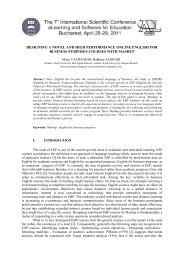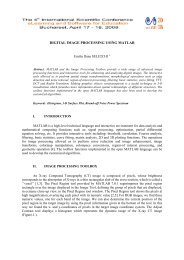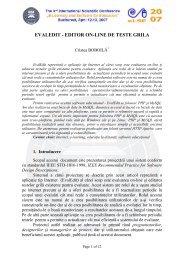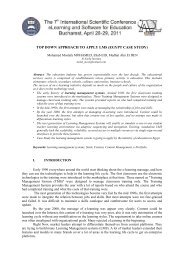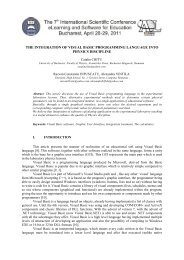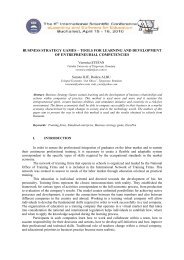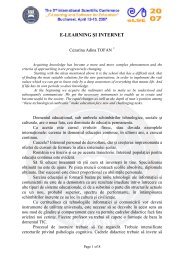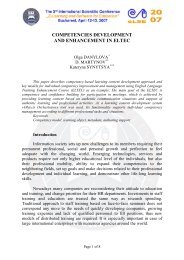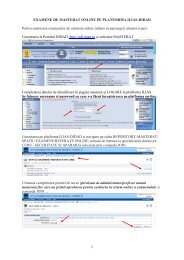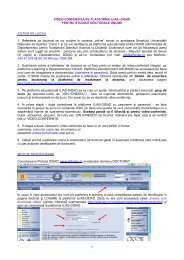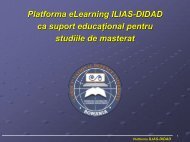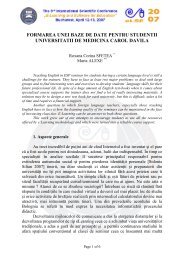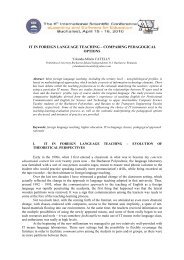the comparative study of hydrocarbons using the e-learning platform
the comparative study of hydrocarbons using the e-learning platform
the comparative study of hydrocarbons using the e-learning platform
You also want an ePaper? Increase the reach of your titles
YUMPU automatically turns print PDFs into web optimized ePapers that Google loves.
THE COMPARATIVE STUDY OF HYDROCARBONS USING THE E-LEARNING<br />
PLATFORM<br />
Simona Marilena ILIE ∗<br />
Crina-Valentina TURCAS ∗ ∗<br />
Maria-Melania MICUT ∗ ∗ ∗<br />
Abstract: The meaning we accept for e-<strong>learning</strong> is synonimous with on-line education, on-line courses,<br />
Web-Based Learning, which doesn't suppose an interaction, permanent communication with a teacher.<br />
The <strong>comparative</strong> visualisation <strong>of</strong> <strong>hydrocarbons</strong> structure and <strong>the</strong>ir main chemical properties<br />
determines an optimal information management.<br />
Because most <strong>hydrocarbons</strong> are gases, making <strong>the</strong> experiment in <strong>the</strong> laboratory requires <strong>using</strong> specific<br />
and complex endowment that only exist and work in safety conditions only within industrial<br />
installations.<br />
Using <strong>the</strong> e-<strong>learning</strong> <strong>platform</strong>s students can perceive clearly and in real terms <strong>the</strong> development<br />
<strong>of</strong> <strong>the</strong> chemical reactions and can deduce <strong>the</strong> practical utilities <strong>of</strong> saturated, unsaturated and aromatic<br />
<strong>hydrocarbons</strong>.<br />
Keywords: e-<strong>learning</strong>, on-line courses, HTML, <strong>hydrocarbons</strong>.<br />
I. INTRODUCTION<br />
Alkanes, alkynes, alkadiene, alkynes and aromatic <strong>hydrocarbons</strong> (arenes) are <strong>hydrocarbons</strong><br />
<strong>the</strong>refore <strong>the</strong>y are organic and <strong>the</strong>ir molecule contains atoms <strong>of</strong> carbon and hydrogen.<br />
• The chemical structure refers to <strong>the</strong> nature, <strong>the</strong> number and <strong>the</strong> way <strong>the</strong> atoms in a molecule<br />
are bound. The physical and chemical properties <strong>of</strong> an organic compound depend on its<br />
structure.<br />
• Establishing <strong>the</strong> structure <strong>of</strong> an organic compound can be done by following <strong>the</strong> next stages:<br />
- Establishing <strong>the</strong> nature and number <strong>of</strong> atoms in a molecule after performing <strong>the</strong><br />
quantity and quality analysis on <strong>the</strong> pure chemical compounds.<br />
- Establishing <strong>the</strong> substance’s composition according to <strong>the</strong> obtained information.<br />
- Deducing <strong>the</strong> empirical formula and <strong>the</strong> molecular formula.<br />
- Establishing <strong>the</strong> way <strong>the</strong> atoms are arranged in <strong>the</strong> molecule (that is shown in <strong>the</strong><br />
structure formulas).<br />
II.<br />
THE E-LEARNING CONCEPT<br />
E-Learning, like <strong>the</strong> convergence between <strong>learning</strong> and Internet, requires that: <strong>the</strong> process <strong>of</strong><br />
<strong>learning</strong> takes place in a virtual classroom; <strong>the</strong> educational material is accessible on <strong>the</strong> internet and<br />
includes text, images, sending to o<strong>the</strong>r online resources, audio and video presentations; <strong>the</strong> virtual<br />
classroom benefits from a teacher-orientation (facilitator, moderator) who plans <strong>the</strong> activity <strong>of</strong> <strong>the</strong><br />
participants’ group, subjects to <strong>the</strong>ir debate aspects <strong>of</strong> <strong>the</strong> course in asynchronous conferences<br />
(discussion forums) or synchronous (Chat), delivers auxiliary resources, comments on homework,<br />
showing everyone where <strong>the</strong>y had to insist;
The course material has a static component – that prepared by <strong>the</strong> facilitator toge<strong>the</strong>r with a<br />
team specialized in instructional design - and a dynamic one, resulted from <strong>the</strong> participants’<br />
interaction, from <strong>the</strong> suggestions, clarifications, commentaries, resources brought by <strong>the</strong>se,<br />
Most <strong>of</strong> <strong>the</strong> means <strong>of</strong> E-Learning permit <strong>the</strong> monitoring <strong>of</strong> <strong>the</strong> participants’ activity, <strong>the</strong> work<br />
in subgroups, <strong>the</strong> audio and video interaction.<br />
III.<br />
THE ADMINISTRATION OF THE PLATFORM<br />
The administration page allows <strong>the</strong> modification <strong>of</strong> <strong>the</strong> information about <strong>the</strong> institution,<br />
users, departments, and <strong>the</strong> distribution <strong>of</strong> <strong>the</strong> users on departments (Fig. 1.). This page is reserved to<br />
<strong>the</strong> super users, that can modify all <strong>the</strong> data about <strong>the</strong>ir institution.<br />
These data is referred to departments, announcements and <strong>the</strong> distribution <strong>of</strong> <strong>the</strong> users on<br />
departments. At <strong>the</strong> level <strong>of</strong> a department <strong>the</strong> domains for tutorials and for <strong>the</strong> forum can be defined,<br />
inclusively administrated by facilitators (Fig. 2.).<br />
Figure 1.<br />
Figure 2.
IV.<br />
ON-LINE COURSES<br />
The on-line cours page contains a set <strong>of</strong> lessons divided on domains (Fig.3).<br />
The access to a certain course can be restricted through <strong>the</strong> use <strong>of</strong> accounts and passwords.<br />
The editor contains <strong>the</strong> most used elements for creating a course, options to add files on <strong>the</strong><br />
site as well as <strong>the</strong> possibility to introduce HTML code if <strong>the</strong> use <strong>of</strong> some more complex constructions<br />
is wished (Fig. 4). The files that contain <strong>the</strong>se lessons can be under <strong>the</strong> form <strong>of</strong>: text, HTML, Power<br />
Point.<br />
Because for understanding <strong>the</strong> elements presented in a lesson some knowledge is needed <strong>the</strong><br />
establishment <strong>of</strong> some preliminary questionnaires to condition <strong>the</strong> access to <strong>the</strong> respective tutorial is<br />
allowed.<br />
The checking <strong>of</strong> <strong>the</strong> level <strong>of</strong> understanding <strong>the</strong> presented information can be done with <strong>the</strong><br />
help <strong>of</strong> a final self-assessment test or with points. The application <strong>of</strong> this mechanism permits <strong>the</strong><br />
organization <strong>of</strong> <strong>the</strong> tutorials in a graph <strong>of</strong> dependence, determining <strong>the</strong> users to look down on <strong>the</strong>m in<br />
a certain order.<br />
The accession degree and <strong>the</strong> completion <strong>of</strong> <strong>the</strong> tutorials from <strong>the</strong> selected department can be<br />
watched.<br />
Figure 3.<br />
Figure 4.
V. CONCLUSIONS<br />
The main advantage <strong>of</strong> this solution is represented by <strong>the</strong> integration <strong>of</strong> <strong>the</strong> main modules<br />
necessary in <strong>the</strong> online <strong>learning</strong> process, being able to be used without <strong>the</strong> help <strong>of</strong> o<strong>the</strong>r programs.<br />
The possibility <strong>of</strong> administrating <strong>the</strong> online courses for <strong>learning</strong> institutions is an important<br />
facility, allowing <strong>the</strong>se to implement an E-Learning system without a hardware infrastructure being<br />
necessary, diminishing <strong>the</strong> cost <strong>of</strong> implementation.<br />
Choosing environment depends on <strong>the</strong> number <strong>of</strong> courses, participants and teachers, on <strong>the</strong><br />
course duration.<br />
A virtual environment is just <strong>the</strong> tool through which <strong>the</strong> access to <strong>the</strong> course material is<br />
assured, <strong>the</strong> teacher-participants’ interaction is made, as well as <strong>the</strong> management <strong>of</strong> content and <strong>of</strong> <strong>the</strong><br />
course activities. Not even <strong>the</strong> most sophisticated environment can’t replace <strong>the</strong> teacher and his art to<br />
engage and motivate participants in a <strong>learning</strong> and collaboration process.<br />
Learning becomes a social process, through interaction and collaboration, <strong>the</strong> group <strong>of</strong> <strong>the</strong><br />
participants and <strong>the</strong> instructor, forms during <strong>the</strong> course, many times and after, a virtual community.<br />
BIBLIOGRAPHY<br />
[1] Carmen Holotescu - Ghid eLearning, Universitatea Politehnica Timisoara, 2005.<br />
[2] Introduction to Programming, Micros<strong>of</strong>t, U.S.A., 2004.<br />
[3] Michael Morrison - HTML & XML for Beginners, Micros<strong>of</strong>t Press, Redmond, Washington,<br />
2001.<br />
[4] Micros<strong>of</strong>t® Security Guidance Training for Developers, Micros<strong>of</strong>t, U.S.A., 2002.<br />
[5] Micros<strong>of</strong>t® Security Guidance Training for Developers II, Micros<strong>of</strong>t, U.S.A., 2004.<br />
[6] Walter Savitch - Java: An Introduction to Computer Science & Programming, Prentice Hall,<br />
New Jersey, 2001.<br />
[7] www.micros<strong>of</strong>t.com<br />
∗ PhD. Candidate, Technical Universiy <strong>of</strong> Civil Engineering, Bucharest<br />
∗∗ Pr<strong>of</strong>esor, University <strong>of</strong> Bucharest<br />
∗∗∗ Pr<strong>of</strong>esor, University <strong>of</strong> Bucharest



